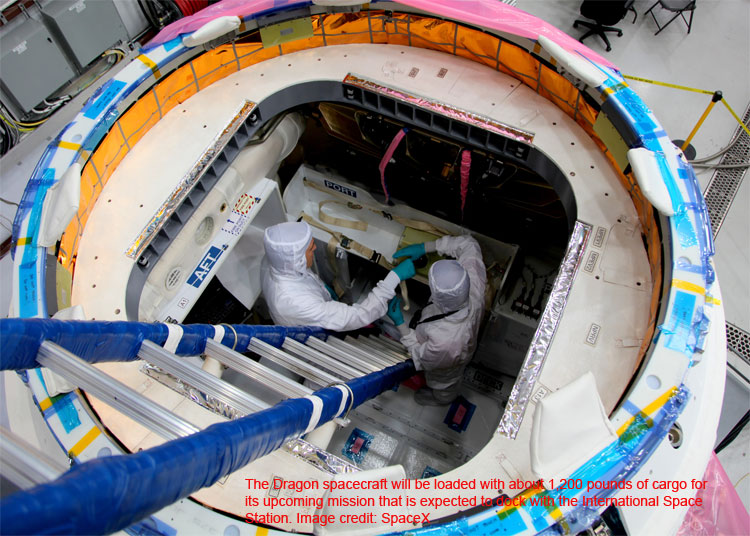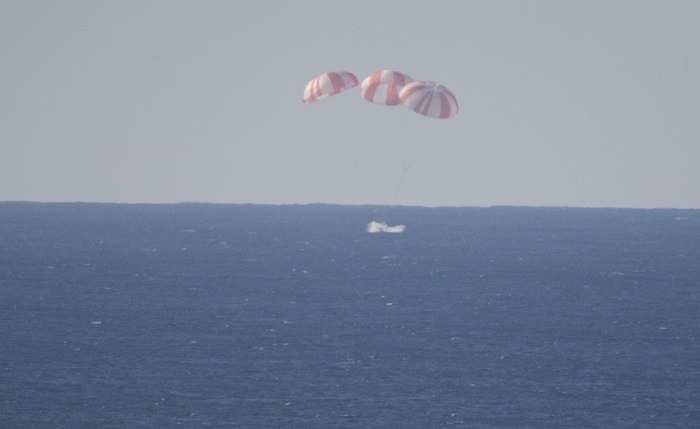.12.04.2012
Die bevorstehende Produkteinführung eines SpaceX Raumfahrzeugs in Form der Dragon-Kapsel und der Träger-Rakete Falcon-9 zu einem Demonstrationsflug zur internationalen Weltraumstation ISS steht kurz bevor, welches ein weiterer Meilenstein zur kommerziellen Raumfahrt darstellt. " Ist fast wie der Weg damals zu Apollo, sagt mein Verstand, " so Mike Horkachuck, NASA' s-Projekthauptleiter für SpaceX. " Wir hatten Mercury, dann Gemini und schließlich hatten wir Apollo. Mit Dragon ist die Richtung ähnlich, noch geht es nicht zum Mond oder anderem Spektakulären, aber wir sind bei den Anfängen unseres Handelns. Dies kann unsere Mercury sein, aus der sich schließlich Space-Crews transportieren und zu langfristigen Passagierflügen führen."
Fotos: SpaceX/NASA







.
Update: 18.01.2014
.
NASA Commercial Crew Partner SpaceX Tests Dragon Parachute System
.

Engineers and safety specialists from NASA and Space Exploration Technologies (SpaceX) gathered in Morro Bay, Calif., in late December to demonstrate how the company's Dragon spacecraft's parachute system would function in the event of an emergency on the launch pad or during ascent.
The test was part of an optional milestone under NASA's Commercial Crew Integrated Capability (CCiCap) initiative and approved by the agency in August. Through the Commercial Crew Program, SpaceX is one of NASA's commercial partners working to develop a new generation of U.S. spacecraft and rockets capable of transporting humans to and from low-Earth orbit from American soil. NASA intends to use such commercial systems to fly U.S. astronauts to and from the International Space Station.
The 12,000-pound test craft was lifted 8,000 feet above sea level by an Erickson Sky Crane helicopter and flown over the Pacific Ocean. Following Dragon's release, two drogue parachutes were released from the top of the spacecraft to slow its decent, before the three main parachutes deployed. The craft splashed down and was quickly recovered by the Sky Crane and carried back to shore.
"The parachute test is essential for the commercial crew effort because it helps us better understand how SpaceX's system performs as it safely returns crew," said Jon Cowart, NASA Partner Integration deputy manager working with SpaceX. "Like all of our partners, SpaceX continues to provide innovative solutions based on NASA's lessons learned that could make spaceflight safer."
During a normal spacecraft landing, the parachutes will be aided by the Dragon’s SuperDraco thrusters to provide a soft controlled landing. This redundancy on both the parachutes and thrusters is designed to ensure safe landings for crews.
"SpaceX is working diligently to make the Dragon spacecraft the safest vehicle ever flown," said Gwynne Shotwell, president of SpaceX. "The parachute system is an integral part of Dragon’s ability to provide a safe landing for nominal and abort conditions -- with this successful test we are well-positioned to execute a full end-to-end test of the launch escape system later this year."
The parachute test puts SpaceX a step closer to launch abort system tests. The company currently is manufacturing the spacecraft and rocket to be used for these flight tests.
SpaceX is on track to complete all 15 of its CCiCap milestones in 2014. All of NASA's industry partners, including SpaceX, continue to meet their established milestones in developing commercial crew transportation capabilities.
.

Quelle: NASA
